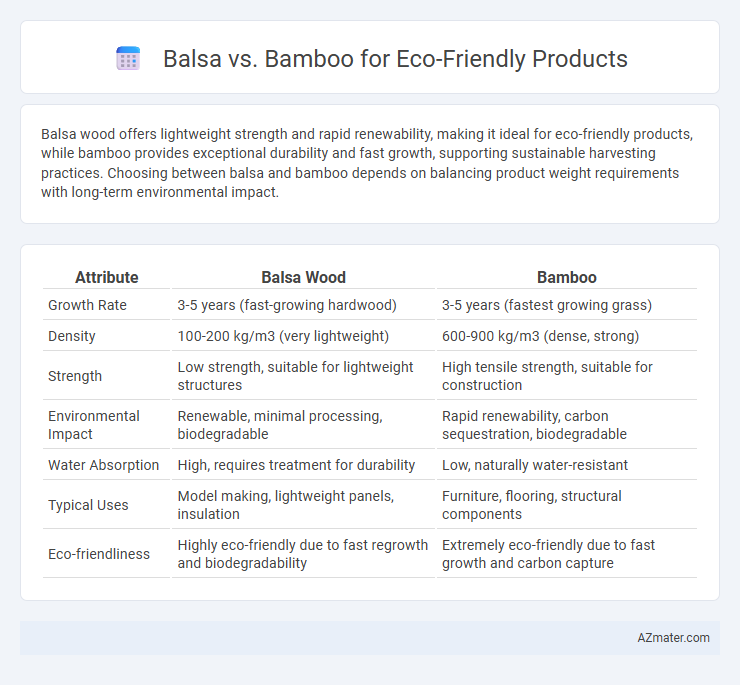Balsa wood offers lightweight strength and rapid renewability, making it ideal for eco-friendly products, while bamboo provides exceptional durability and fast growth, supporting sustainable harvesting practices. Choosing between balsa and bamboo depends on balancing product weight requirements with long-term environmental impact.
Table of Comparison
| Attribute | Balsa Wood | Bamboo |
|---|---|---|
| Growth Rate | 3-5 years (fast-growing hardwood) | 3-5 years (fastest growing grass) |
| Density | 100-200 kg/m3 (very lightweight) | 600-900 kg/m3 (dense, strong) |
| Strength | Low strength, suitable for lightweight structures | High tensile strength, suitable for construction |
| Environmental Impact | Renewable, minimal processing, biodegradable | Rapid renewability, carbon sequestration, biodegradable |
| Water Absorption | High, requires treatment for durability | Low, naturally water-resistant |
| Typical Uses | Model making, lightweight panels, insulation | Furniture, flooring, structural components |
| Eco-friendliness | Highly eco-friendly due to fast regrowth and biodegradability | Extremely eco-friendly due to fast growth and carbon capture |
Introduction to Eco-Friendly Materials: Balsa and Bamboo
Balsa and bamboo are two popular eco-friendly materials known for their sustainability and rapid growth cycles, making them ideal choices for environmentally conscious products. Balsa wood, prized for its exceptionally light weight and strength, grows primarily in South America and supports carbon sequestration through fast reforestation. Bamboo, a fast-growing grass native to Asia, offers remarkable tensile strength and versatility, promoting soil health and reducing deforestation impacts.
Sustainability: Renewability and Growth Rates
Balsa and bamboo are both highly sustainable materials, with bamboo boasting a rapid growth rate of up to 3 feet per day, making it one of the fastest renewable resources on Earth. Balsa grows more slowly but is still renewable, typically maturing in 5-10 years, offering a lightweight fiber ideal for eco-friendly products. Bamboo's ability to regenerate without replanting and its high carbon sequestration capacity further enhance its environmental benefits compared to balsa.
Environmental Impact: Harvesting and Processing
Balsa wood, known for its fast growth and lightweight properties, has a relatively low environmental impact during harvesting due to its renewable nature, but requires energy-intensive drying processes that can increase its carbon footprint. Bamboo, as a rapidly renewable grass, regenerates quickly without the need for replanting, significantly reducing soil erosion and habitat disruption, with its processing methods often involving less chemical treatment compared to wood. Both materials offer sustainable options, yet bamboo's regenerative growth and minimal processing impact make it particularly advantageous for eco-friendly product manufacturing.
Material Properties: Strength, Weight, and Flexibility
Balsa wood offers exceptional lightness with a density around 160 kg/m3, making it one of the lightest commercial woods, while bamboo typically has densities ranging from 600 to 700 kg/m3, providing greater strength and durability. Bamboo's tensile strength can reach up to 370 MPa, surpassing steel in specific strength, whereas balsa's flexural strength is lower but sufficient for applications requiring flexibility and impact absorption. Both materials are sustainable, but bamboo's high strength-to-weight ratio and flexibility make it ideal for structural uses, while balsa excels in lightweight, cushioning, and insulation applications.
Common Applications: Balsa vs Bamboo Products
Balsa wood, known for its ultra-lightweight and buoyant properties, is commonly used in model airplanes, lightweight furniture, and insulation panels, offering sustainability through rapid growth and biodegradability. Bamboo, prized for its strength and flexibility, finds extensive applications in flooring, construction scaffolding, and eco-friendly textiles, providing a renewable alternative that sequesters high amounts of carbon. Both materials serve as environmentally friendly options but cater to different functional needs based on density and mechanical properties.
Cost Comparison: Affordability and Availability
Balsa wood is generally more expensive than bamboo due to its limited availability and slower growth rate, resulting in higher production costs. Bamboo is significantly more affordable and widely accessible worldwide, benefiting from rapid growth and ease of cultivation. The cost-efficiency and renewable nature of bamboo make it a preferred choice for eco-friendly products, especially in large-scale manufacturing.
Durability and Lifespan in Eco-Friendly Products
Balsa wood offers moderate durability with a lifespan suited for lightweight eco-friendly products, prized for its exceptional strength-to-weight ratio but prone to moisture damage without proper treatment. Bamboo demonstrates superior durability and longevity, naturally resistant to pests and environmental wear, making it ideal for sustainable products requiring long-term use. Both materials contribute to eco-friendly manufacturing, yet bamboo's robustness ensures greater lifespan and reliability in demanding applications.
Aesthetic Appeal and Design Versatility
Balsa offers a lightweight texture with a smooth, pale finish that enhances minimalist and modern eco-friendly product designs. Bamboo features a rich, natural grain and sturdy structure, providing greater versatility for intricate patterns and diverse aesthetic styles. Both materials support sustainable design, but bamboo's strength allows for more dynamic and durable product applications.
Challenges and Limitations of Balsa and Bamboo
Balsa wood faces challenges such as limited availability due to slow growth rates and sensitivity to pests, affecting its sustainable harvesting. Bamboo, while fast-growing and renewable, encounters limitations including susceptibility to fungal decay and variability in strength across species. Both materials require careful processing and treatment to enhance durability, which can impact their overall environmental footprint in eco-friendly product manufacturing.
Choosing the Right Material for Your Eco-Friendly Product
Balsa wood, known for its lightweight and softness, offers excellent insulation and ease of shaping, making it ideal for eco-friendly products requiring minimal environmental impact during processing. Bamboo, a fast-growing grass with superior strength and durability, provides a renewable and biodegradable option perfect for sturdy, long-lasting eco-friendly items. Selecting between balsa and bamboo depends on product requirements for weight, strength, and sustainability goals, ensuring optimal material performance while minimizing ecological footprint.

Infographic: Balsa vs Bamboo for Eco-friendly Product
 azmater.com
azmater.com